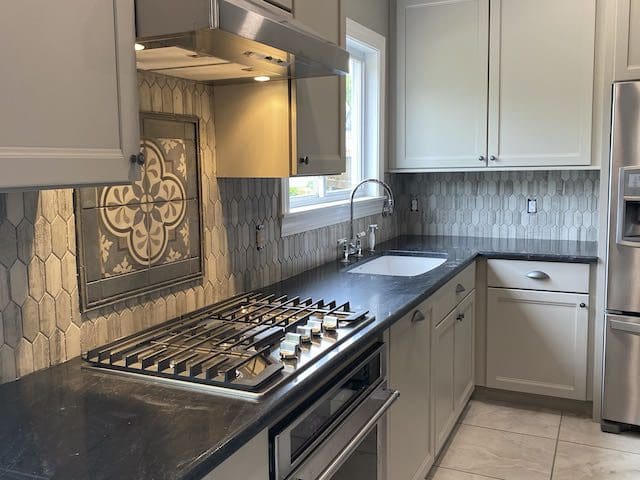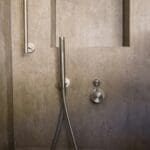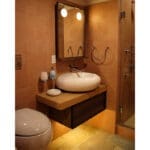Gas Or Electric Cooktop: A Homeowner’s Guide
Author: Thomas Borcherding | Updated On:
The History Of Electric Cooktops
The world’s very first electric cooktop was invented in 1892, and subsequently showcased at the Chicago World’s Fair in 1893. It wasn’t until the 1930s, however, that the electric cooktop started gaining mass adoption. Prior to the 1930s, gas stoves reigned supreme, largely due to the high cost of electricity alongside the new technology’s lack of performance.

Fast forward to today and we see the polar opposite. In fact, gas cooktops are being banned all over the U.S. This comes as cities are rapidly enacting regulations that ban natural gas connections in new construction.
Major cities such as Denver, New York, San Francisco, and Seattle have already proposed measures, or banned, hooking up both residential and commercial new buildings to natural gas lines.
These enactments are in effort to combat climate change by reducing the emission of greenhouse gases. As America’s energy grid becomes increasingly green, it tends to make sense for a shift to happen from natural gas to electric energy.
Such large changes have, understandably, upset some people. Loud criticism has been made by professional chefs, who say that the switch to electric would be detrimental to their cooking. In fact, the California Restaurant Association has even filed suit against Berkeley, California, a city that has passed the new regulation. Said lawsuit was dismissed, however, by the federal district court in 2021.
Nevertheless, homeowners with gas connections already installed will not be asked to disconnect, and the probability still remains low that such a law will even be passed for the vast majority of Americans.
Several states have outlawed their municipalities from enacting such changes, including Kansas, Louisiana, Tennessee, Oklahoma, and Arizona.
So, rest easy knowing that your choice between gas and electric cooktops likely remains the same, especially if you’re just remodeling. We explore the pros and cons of each below.
Surface Scratching
Smooth-top electric ranges, whether they are in the form of induction or below-glass coils, are not immune to having their ceramic-glass coating scratched.
In kitchen remodels that we have done for clients, we have seen their brand-new glass cooktop get scratched within months. This isn’t guaranteed to happen with a glass cooktop.
As long as you are gentle with your pots and pans, your glass will remain scratch free. Furthermore, some scratches in a glass cooktop can even be repaired using simple touch-up kits.
Air Quality
Despite boasting arguably better heating of pots and pans, gas ranges can often cause a room to exceed indoor guidelines on Nitrogen Dioxide (NO₂).
Often times the maximum recommended peak level is double what it should be when cooking with gas. Other particulates that are produced by burning methane are carbon monoxide, nitrogen oxide, as well as formaldehyde.
This shouldn’t be a problem, of course, with proper ventilation, whether it be a downdraft or an updraft. For proper ventilation the duct-work should run outside as opposed to into the attic.
It’s important to note that the efficiency of kitchen ventilation varies widely, with hoods capturing anywhere from 15 to 98 percent of emissions. Thus, gas ranges can run more expensive once you factor in the need to install a high quality ventilation fan alongside it.
Required Pots
Induction cooking is in its own ballgame when it comes to pots and pans. Induction cooktops work by creating a magnetic field between the magnetic coils beneath the cooking surface and the pot itself.
That means that the pots you cook with are going to have to contain ferromagnetic materials; think iron or stainless steel. Compatible cookware includes cast iron, enameled cast iron, stainless-steel cookware, and carbon steel. Copper, glass, and aluminum cookware will not work with induction.
Ease of Cleaning
Electric cooktops reign supreme when it comes to cleaning. Being able to simply wipe across the entire cooktop is a huge benefit. The alternative, with gas, is having to take the heavy iron grids out, soak them, and clean around the burners.
It is advised to not use heavy, abrasive cleaning solutions or pads when cleaning the smooth-tops, because again, they are not scratch proof. We have seen clients ruin their electric cooktops by using improper cleaning techniques.
Gas Works When Electric Doesn’t
That is to say, your gas cooktop will not fail you when there is a power outage. Your backup generator may not even be enough to power your electric cooktop, given the need for a dedicated 220-volt connection.
This 220-volt connection then requires a likely minimum of 30-amps, which is dozens of lightbulbs you could be powering otherwise. So, if frequent power outages are something you experience regularly then a gas-powered stove is going to be what you want.
Gas Heats Immediately and Gives You Control
The main appeal to chefs when deciding between gas or electric is that fact that a gas cooktop will heat immediately. A smooth-top will take time to heat up, and this time greatly impacts a chef’s cooking routine.
With gas, you get immediate heat from a flame that can be applied directly to the pot while it also heats up the metal elements above it. Furthermore, cooking with gas gives the chef greater control over the temperature of the heat applied to the food. 72 percent of professional chefs say that temperature control is their primary factor in choosing gas burners over electric.
All in all, both forms of cooktops are perfectly valid methods of cooking. The decision ultimately comes down to personal preference. For a household that has a family member afflicted with asthma or other respiratory problems, we strongly suggest going with electric, as multiple studies show that gas stovetops can exacerbate asthma symptoms.
This con is offset by gas’s arguably superior heat control that allows for precise cooking. It’s a big decision to choose either gas or electric stovetops, but we hope that we have made the choice a little bit easier.
About the Author

Thomas Borcherding is a professional kitchen & bath designer, and a member of the National Kitchen & Bath Association (NKBA). He is the second-generation owner of Homestar Design Remodel, and takes great joy in providing those in St. Louis with high-quality, affordable home remodeling.







